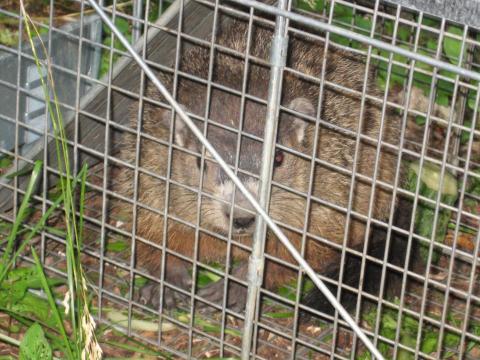You are on eastlansinginfo.org, ELi's old domain, which is now an archive of news (as of early April, 2020). If you are looking for the latest news, go to eastlansinginfo.news and update your bookmarks accordingly!
You are on eastlansinginfo.org, ELi's old domain, which is now an archive of news (as of early April, 2020). If you are looking for the latest news, go to eastlansinginfo.news and update your bookmarks accordingly!

Image: A woodchuck that the author captured using a live trap in his East Lansing garden.
After a winter of hibernation in their large and complicated burrows, whistle pigs are out and devouring gardens in East Lansing.
The whistle pig—aliases woodchuck, groundhog, and Marmota monax—are rodents of unusual size with a range throughout much of North America. Woodchucks who live near a favorite and plentiful food source (for example, an alfalfa field) can grow to be 30 inches long and 30 pounds, but most woodchucks are 15-25 inches long and weigh 4 to 9 pounds.
Woodchucks, groundhogs, and whistle pigs are all the same animal. The name “woodchuck” has nothing to do with chucking wood, and the claim that “woodchuck” comes from an Algonquian word (wuchak) is controversial. The name “whistle pig” comes from the sentinel behavior of adult woodchucks who will stand on their hind legs and whistle a warning to other woodchucks when they see a predator.
Groundhogs are excellent diggers and build complicated burrows with five or more entrances and multiple chambers, covering upwards of 50 linear feet at a depth of five feet. As with many rodents, including rats, each chamber of a groundhog’s burrow serves a different purpose; for example, a sleeping chamber will be kept separate from a toilet chamber. Unlike rats, groundhogs do not store food for the winter; groundhogs hibernate.
Hibernation overall is not well understood, but we know that a range of animals from butterflies (insects) to lemurs (primates) enter some form of hibernation. Most animals that truly hibernate do so to avoid winter, and allow their temperatures to drop twenty or thirty degrees to conserve energy.
As winter approaches, woodchucks fatten themselves as much as possible and dig themselves into a chamber below the frost line to enter hibernation. Whistle pigs enter this true hibernation for three to six months, depending on their climate. There are some local rodents, like the Eastern chipmunk, who enter a deep winter sleep but do not drop their temperature much from normal and don’t enter a “true” hibernation.
Woodchucks are big eaters and big diggers. Their digging can undermine the foundation of a shed or a house, and a woodchuck can easily destroy a neighborhood garden. They and their marmot kin have long been hunted as a nuisance as well as a source of food and fur.
East Lansing resident woodchucks can be successfully live trapped by using fresh vegetables as bait. (Hardware stores and birdseed stores often have large “have a heart” traps available for rental.) Woodchucks tend to prefer mild green vegetables, like cucumber and lettuce. Indeed, woodchucks tend to leave alone stronger tasting greens like basil, parsley, and arugula. About a woodchuck we shared, my neighbor Joe observed to me, “Aron, this woodchuck is a bigot. He eats my lettuce and my cabbage, but all of my Italian vegetables are untouched.”
The following video shows the author and his family at a nature park several years ago, releasing a woodchuck captured in their East Lansing backyard.
eastlansinginfo.org © 2013-2020 East Lansing Info